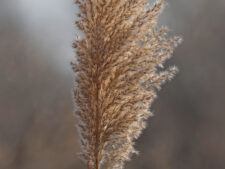
Our largest grass, this perennial with stout, round stems up to 12 feet tall and 1 inch in diameter, has extensive, stout rhizomes which form large colonies in wet areas (B). The numerous smooth, flat leaf blades are up to 24 inches long and 1 1/2 inches wide. Flower clusters are large (up to 14 inches long), dense, light brown to purplish panicles with ascending branches (A). As the plant matures the tips and branches nod. Panicles develop a plume-like feathery appearance late in the season when the long silky hairs on the tiny stems (rachillae) bearing the flowers become more visible (C).
Wet soil in marshes, ditches, margins of streams, lakes and ponds. This plant is common along the edge of the Great Marsh (B) in Fontenelle Forest. At Neale Woods it is uncommon in floodplain sites off-trail.
Common Reed has a worldwide distribution. Populations in this country include both native and introduced plants. The aggressive behavior of some introduced strains has prompted its classification as a noxious weed in several states. Native Americans used Common Reed for thatching and mats and made arrow shafts from its stems. Other cultures have utilized the seeds, leaves and rhizomes for food. It provides good cover for birds and small mammals as well as nesting sites for waterfowl and small birds. The rhizomes are a food source for muskrats.
The content of NatureSearch is provided by dedicated volunteer Naturalists of Fontenelle Forest who strive to provide the most accurate information available. Contributors of the images retain their copyrights. The point of contact for this page is: Neal Ratzlaff.



